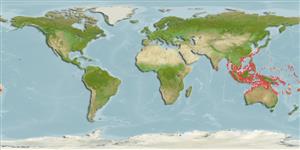Common names from other countries
>
Tetraodontiformes (Puffers and filefishes) >
Monacanthidae (Filefishes)
Etymology: Paramonacanthus: Greek, para = the side of + Greek, monos = one + Greek, akantha ) thorn (Ref. 45335).
Issue
This speces is valid according to several authors in CofF (ver. 11 May 2022).
Environment: milieu / climate zone / depth range / distribution range
Οικολογία
Θαλασσινό(ά) Υφαλόφιλο(α); ωκεανόδρομο(ς) (Ref. 51243); εύρος βάθους 34 - 46 m (Ref. 33352). Tropical; 35°N - 31°N, 130°E - 141°E
Northwestern Pacific: confirmed from Japan.
Μέγεθος / Βάρος / Age
Maturity: Lm ? range ? - ? cm
Max length : 12.0 cm SL αρσενικό/απροσδιόριστο; (Ref. 48637)
Ραχιαίες άκανθες (συνολικά) : 2; Μαλακές ραχιαίες ακτίνες (συνολικά) : 24 - 30; Εδρικές άκανθες: 0; Μαλακές εδρικές ακτίνες: 24 - 30; Σπόνδυλοι: 19. body width 2.0-2.6 in head length; body depth 2.0-3.1 in SL, head length 2.7-3.2 in SL; snout length 3.7-4.1 in SL; eye diameter 2.7-3.7 in head length; second dorsalmost caudal ray elongate and filamentous in male (Ref. 33065).
Inhabits weedy and sandy areas of coastal reefs (Ref. 9710). Found on open muddy substrates from shallow estuaries to deep offshore. Males elongate with age (Ref. 48637). Monogamous (Ref. 52884).
Masuda, H., K. Amaoka, C. Araga, T. Uyeno and T. Yoshino, 1984. The fishes of the Japanese Archipelago. Vol. 1. Tokai University Press, Tokyo, Japan. 437 p. (text). (Ref. 559)
IUCN Red List Status (Ref. 130435)
CITES (Ref. 128078)
Not Evaluated
Threat to humans
Harmless
Human uses
Εργαλεία
Special reports
Download XML
Διαδικτυακές πηγές
Estimates based on models
Preferred temperature (Ref.
115969): 24.6 - 28.4, mean 27.6 (based on 106 cells).
Phylogenetic diversity index (Ref.
82804): PD
50 = 0.5000 [Uniqueness, from 0.5 = low to 2.0 = high].
Bayesian length-weight: a=0.01862 (0.01139 - 0.03045), b=2.86 (2.72 - 3.00), in cm Total Length, based on LWR estimates for this species & (Sub)family-body (Ref.
93245).
Τροφικό Επίπεδο (Ref.
69278): 2.8 ±0.25 se; based on food items.
Ελαστικότητα (Ref.
120179): Μεσαίο(α), ελάχιστος χρόνος για διπλασιασμό πληθυσμού 1,4 - 4,4 έτη (Fec = 3,300).
Fishing Vulnerability (Ref.
59153): Low vulnerability (10 of 100).
